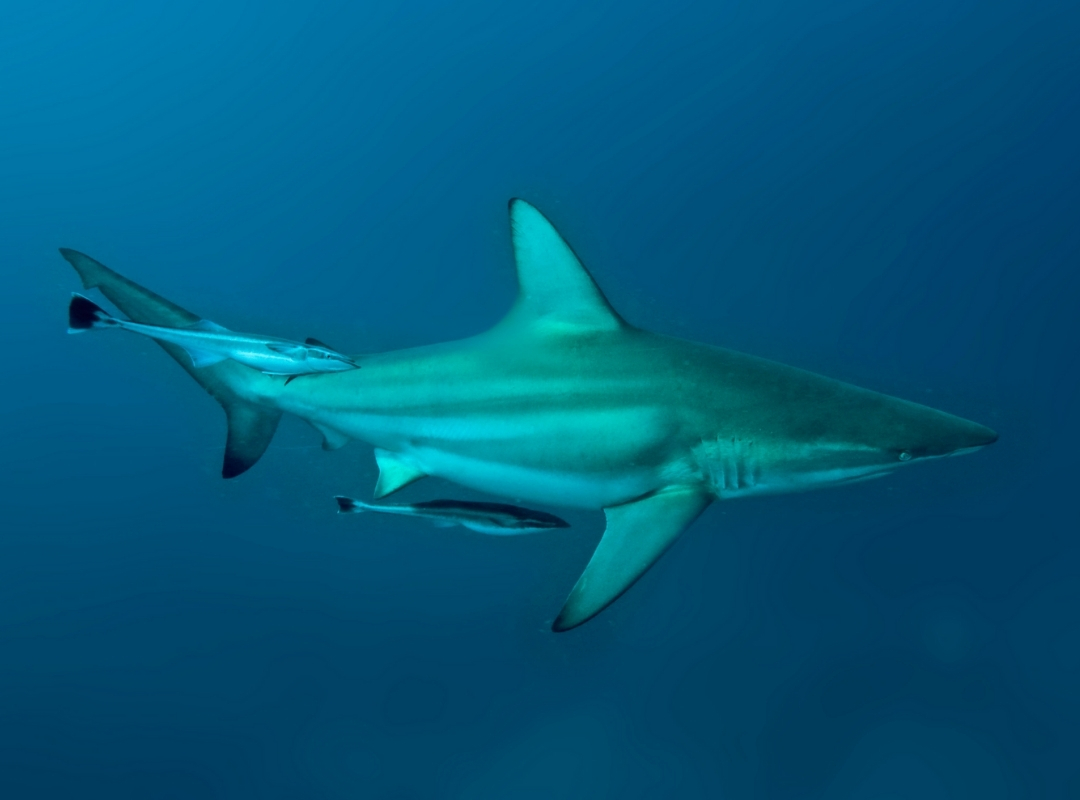Species Name
Silky Shark
Scientific Name
Carcharhinus falciformis
Family Name
Carcharhinidae
IUCN Status
Vulnerable
A large slender shark; moderately extended rounded snout; the first dorsal fin is rounded and the second dorsal fin is free with a long tip; pectoral fins are long and slender with dusky tips; oblique-cusped serrated teeth in the upper jaw present.
Biology
Length: Silky sharks typically reach a length of around 8 to 10 feet (2.4 to 3 meters), but they can grow up to approximately 12 feet (3.7 meters).
Gestation period: 9 to 12 months.
Littter size: Silky sharks are viviparous, meaning they give birth to live young. The litter size can vary but usually ranges from 2 to 14 pups.
Life Expectancy: Silky sharks have an average lifespan of about 22 to 23 years.
Diet: The diet of silky sharks is varied and they are opportunistic predators. They mainly eat tiny sharks, cephalopods (like squids and octopuses), and bony fish. They have a reputation for hunting near the surface at night and diving deeper to obtain prey during the day.
Habitat and Distribution
Habitat: It is commonly found near the edges of continental shelves and over deepwater reefs where there is abundant food source. It is an active, swift shark that prefers warmer water (about 23°C).
Distribution: The silky shark has a wide distribution range and can be found in all major oceans. It is commonly encountered in tropical and subtropical regions, as well as warm temperate waters.
Depth: Although essentially pelagic, the silky shark is not restricted to the open ocean and has been recorded from depths as shallow as 18 meters (56 ft). Typically, it ranges from the surface down to at least 500 meters (1,550 ft) but has been caught over water as deep as 4000 meters (12,400 ft).
Known landing centres: Thoothukudi, Threshpuram, Tharuvaikulam, Vembar, Vellapatti Junglighat, Burmanallah, Wandoor, and Dignabad, Cochin Fisheries Harbour, New Ferry Wharf, Veraval, Mangrol, Porbander and Okha.
Commercial Value
They are taken in large quantities for local consumption, Silky sharks rank among the three most important sharks in the global shark fin trade, with between half a million and one and a half million Silky Shark traded annually. This is a dominant species in Indian fisheries, but not exploited by purse seiners setting on FADs, which is considered to be the greatest risk to juveniles of this species. They are captured on longlines.
Threats
This is a low-productivity species that are subject to high or very high fishing pressure; silky shark received a high ecological risk assessment (ERA) ranking for longline gear because it was estimated as one of the least productive shark species.
References
- Bonfil, Ramón. (2009). The Biology and Ecology of the Silky Shark, Carcharhinus Falciformis. 10.1002/9781444302516.ch10.
- Filmalter, John & Dagorn, Laurent & Cowley, Paul & Taquet, Marc. (2011). First Descriptions of the Behavior of Silky Sharks, Carcharhinus Falciformis, Around Drifting Fish Aggregating Devices in the Indian Ocean. Bulletin of Marine Science. 87. 325-337. 10.5343/bms.2010.1057.


Related Species
- Tiger Shark
- Blacktip Reef Shark
- Common Blacktip Shark
- Spot-tail Shark
- Milk Shark
- Spadenose Shark
- Bignose Shark
- Blackspot Shark
- Blue Shark
- Broadfin Shark
- Bull Shark
- Dusky Shark
- Ganges Shark
- Graceful Shark
- Grey Reef Shark
- Grey Sharpnose Shark
- Hardnose Shark
- Sliteye Shark
- Silvertip Shark
- Sharptooth Lemon Shark
- Sandbar Shark
- Pondicherry Shark
- Pigeye Shark
- Oceanic Whitetip Shark
- Irrawaddy River Shark
- Speartooth Shark
- Spinner Shark
- Whitecheek Shark
- Whitetip Reef Shark

